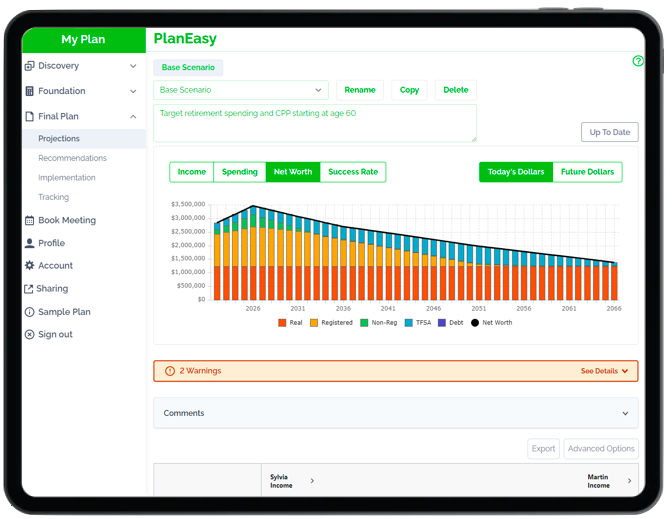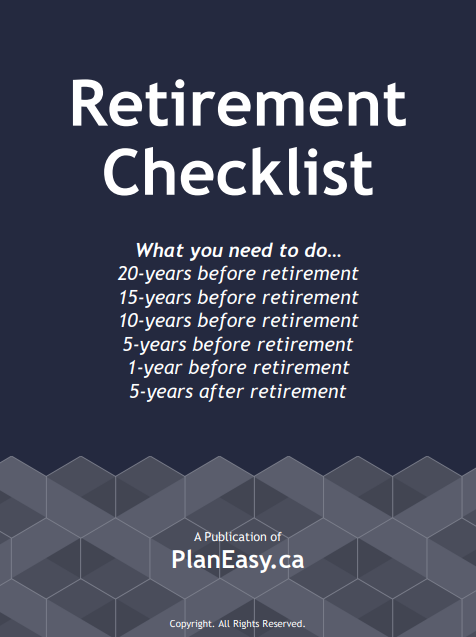Should You Add GICs To Your Investment Portfolio?
For 10+ years interest rates were at historic lows and investing with GICs was less attractive. But now interest rates are higher and adding GICs to your investment portfolio has become much more attractive.
If you don’t have GICs in your investment portfolio, then you may want to consider including some within your fixed-income asset allocation.
GICs (Guaranteed Investment Certificates) are a type of fixed-income investment. They’re extremely safe and in most cases are fully insured by the CDIC (Canadian Deposit Insurance Corporation) up to $100,000 per financial institution.
GICs are guaranteed. They’re like a savings account but with a higher interest rate. GICs are often locked in for a specific term. Terms can be as short as 30-days and as long as 10-years. But most GICs have terms of 1-year, 2-years, 3-years, 4-years, and 5-years.
Adding GICs to your investment portfolio can be very easy. It’s possible to buy GICs from many financial institutions directly OR to buy GICs through your brokerage account.
With interest rates higher, investing with GICs has become more attractive, and in some cases, GICs can even perform better than bonds!
Disclaimer: We hold 5% of our portfolio in GICs and have for a long-time. This makes up part of our fixed-income asset allocation.
How To Add GICs To Your Portfolio
When adding GICs to your investment portfolio it’s important to maintain your overall target asset allocation.
Asset allocation is your mixture of equities and fixed-income. A 60/40 asset allocation means that 60% of the portfolio is invested in equities and 40% of the portfolio is invested in fixed-income like bonds or GICs. An 80/20 asset allocation means 80% in equities and 20% in fixed-income.
Your asset allocation should reflect your risk profile. If you haven’t already, I recommend completing an online risk assessment to help determine the right asset allocation for you.
Your asset allocation will influence your rate of return and investment volatility. In general, the more equities and less fixed-income, the higher the rate of return but the higher the volatility.
When adding GICs to your portfolio it’s important to include GICs as part of your fixed-income asset allocation.
If you add GICs on top of an existing portfolio, you’re making the overall portfolio too conservative, which lowers volatility but also lowers the expected rate of return.
In general, we don’t want an investment portfolio to be too conservative because although this decreases investment risk, it increases other risks like inflation rate risk and longevity risk.
How GICs Perform Vs Bonds
GICs and bonds perform differently. They are both a type of fixed-income investment, but they behave differently. Bonds can increase and decrease in value based on changes in interest rates. Bonds can be bought and sold and are generally more liquid. GICs on the other hand are typically locked in for a specific period of time and do not change in value.
GICs might seem like a boring investment option but in certain historical periods GICs have actually outperformed bonds of equal length/duration.
The folks at Portfolio Manager Blog have done an excellent analysis that shows that over certain periods a 5-year GIC ladder has provided the same or higher return as an equivalent bond fund. This means that a GIC ladder could make a good addition to an investment portfolio.
As mentioned above, adding GICs to the portfolio does not mean adding them on top of the existing portfolio, this creates a risk of making the overall portfolio too conservative. Instead, GICs should replace a portion of the fixed-income allocation.
Watch The Video!
GICs Are Harder To Rebalance
One of the reasons GICs should only make up a portion of the fixed-income allocation is because GICs are harder to rebalance. When equity values decline, its much easier to sell some of your bond holdings to help rebalance the portfolio. When equity values increase, its much easier to purchase some extra bond holdings to help rebalance the portfolio.
This isn’t possible with GICs. GICs are typically locked in for a period of time, which makes it harder to rebalance the portfolio using only GICs.
Instead of only using GICs you should use GICs and bonds together as part of your investment portfolio. Bonds are more liquid and easier to rebalance but GICs are more stable and do not fluctuate in value.
Staying Under The CDIC Limit
For larger portfolios, one important consideration is the CDIC limit of $100,000 per account type per financial institution.
This limit of $100,000 includes interest earned, so its important that interest growth be taken into account. For example, when a GIC is paying 5% interest each year for 5-years the initial investment should be less than $78,000 to ensure that with interest growth the total amount stays below $100,000.
Purchasing GICs Through A Brokerage Account
Although you can purchase GICs directly from a financial institution, this can become annoying when funds are inside a TFSA or RRSP, especially if you want to shop around for the best GIC rate in the future. Moving TFSA or RRSP funds from one financial institution to another can incur account transfer fees of $150+.
Instead, consider purchasing GICs through a brokerage account. The rate may be 10-25 bps lower, but the benefit is that there are no transfer fees and its easy to shop around for the best rate in the future.
For larger accounts, when purchasing GICs through a brokerage account, it’s also easier to purchase GICs from multiple financial institutions to stay under the CDIC limit of $100,000.
Most brokers publish a rate bulletin daily with the latest GIC rates available. Here is the bulletin for Questrade.
Adding GICs To Your Portfolio
If you’re using exchange traded funds (ETFs), a robo-advisor, or an investment advisor to help manage your portfolio then it’s important to coordinate to ensure that adding GICs does not make the overall portfolio too conservative.
Example #1: To achieve an overall 75/25 asset allocation using an “all-in-one” ETF would require that about 6% of the portfolio be invested in GICs and 94% of the portfolio be invested in an 80/20 “all-in-one” ETF. This would result in the target 75% allocation to equities (94% x 80% = 75%), a 19% allocation to bonds, and a 6% allocation to GICs.
Example #2: To achieve an overall 60/40 asset allocation using an “all-in-one” ETF would require that about 25% of the portfolio be invested in GICs and 75% of the portfolio be invested in an 80/20 “all-in-one” ETF. This would result in the target 60% allocation to equities (75% x 80% = 60%), a 15% allocation to bonds, and a 25% allocation to GICs.
Example #3: To achieve an overall 90/10 asset allocation using two ETFs would require that about 5% of the portfolio be invested in GICs, 5% of the portfolio be invested in a bond ETF, and 90% of the portfolio be invested in an 100/0 “all-in-one” ETF.
Fine tuning the mix between equities, bonds, and GICs becomes much easier when adding a second ETF to the investment portfolio but this does increase the complexity.
Blog post continues below...
Advice-Only Retirement Planning
Are you on the right track for retirement? Do you have a detailed decumulation plan in place? Do you know where you will draw from in retirement? Use the Adviice platform to generate your own AI driven retirement decumulation plan. Plan your final years of accumulation and decumulation. Reduce tax liability. Estimate "safe" vs "max" retirement spending. Calculate CPP, OAS, GIS, CCB etc. And much more!
Start your retirement plan for just $9 for 30-days!
You deserve financial peace of mind as you enter retirement. Start planning now!

Adding GICs To Your Investment Portfolio: Pros and Cons
As you can see, there is a lot to think about when adding GICs to your investment portfolio. Here is a quick summary of just some of the pros and cons.
Pros of GICs:
- Guaranteed rate of return
- Principal is guaranteed at the end of the term
- Value of GIC doesn’t fluctuate with interest rates over time
- No investment fees
- Can be CDIC insured up to $100,000 per financial institution
- Can sometimes provide better return than equivalent bond portfolio
- Adds diversification to a portfolio
- Can provide peace of mind
Cons of GICs:
- Not liquid and typically locked in for a specific term (often 1, 2, 3, 4, 5 years)
- Hard to rebalance with the rest of the portfolio
- Can make a portfolio too conservative if simply layered on top of an existing portfolio
- Value doesn’t go up when interest rates go down (like bond funds)
- Harder to shop around for higher rates
Should You Add GICs To Your Investment Portfolio?
Should you add GICs to your investment portfolio? If you like the idea of owning GICs at current rates, then you should absolutely consider adding GICs to your investment portfolio.
Just remember to maintain your target asset allocation between equities and fixed-income. Consider how your other fixed-income investments may need to change when adding GICs to your portfolio.
Also consider how you want to purchase GICs, is it directly from a financial institution or through a brokerage account?
GICs are an important type of fixed-income investment. Their guaranteed value and predictable rate of return are very attractive and they can be easily added to any investment portfolio.
Join over 250,000 people reading PlanEasy.ca each year. New blog posts weekly!
Tax planning, benefit optimization, budgeting, family planning, retirement planning and more...
Join over 250,000 people reading PlanEasy.ca each year. New blog posts weekly!
Tax planning, benefit optimization, budgeting, family planning, retirement planning and more...








0 Comments